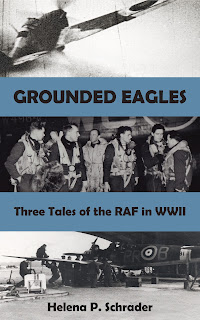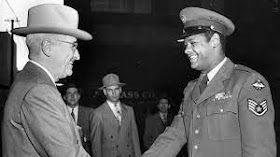While observers can see what is happening, only decision-makers, or those close to them, know why things happen. A novel which seeks to give readers an understanding of historical events requires some characters with access to the historical figures who made history. The characters in the "Eagle's View" plot line are men on the fringes of those in power.
The most powerful political leaders in the era of "Cold Peace" were the Soviet dictator Joseph Stalin, the American President Harry Truman, and the British Prime Minister Clement Attlee. That said, while they were the ultimate arbiters of what happened with respect to Berlin, they were not present on the ground nor did the Berlin crisis occupy the center of their focus. The politicians most engaged in Berlin were the respective military governors and commandants of Berlin. Finally, although Germany had no government and Berlin was treated as an object by the four occupying powers, the people of Berlin found their voice and surprised Moscow no less than Washington and London by speaking up. Ultimately, they forced the powerful occupation powers to take their wishes into account. Without doubt, the spokesman for Berlin in this era was the popularly elected mayor Ernst Reuter.
Throughout the Berlin Crisis of 1948-1949, the Berlin City Council played a critical role -- one all too often overlooked by military historians fascinated by the logistical accomplishments of the Airlift and by political historians of the Cold War mesmerized by the superpower duel that played out in Berlin. To highlight the Berlin City Council and provide insight into its position, I created a fictional member of that body. The Council was 130 members strong, roughly 20 of those members formed the executive body, and the Social Democratic Party formed the largest faction. I made my fictional city council member, Jakob Liebherr, a representative from the traditionally Social Democratic borough of Kreuzberg and his fictional biography corresponds to that of many Social Democratic politicians of this period. Namely, he is a man who had opposed Hitler before the war, voted against the Enabling Law, and spent time in concentration camps for his opposition to National Socialism. Because of his past, Reuter trusts him with a position in the executive body of the city council.
The historical photo below, while not directly relevant to Cold Peace, in my opinion beautifully illustrates the role that anonymous (or fictional) characters who interact with historical figures can play in our understanding of a period or person.
Cold Peace is Book I of the Bridge to Tomorrow Series.
Three years after WWII, Europe struggles with rationing, widespread unemployment and a growing Soviet threat. Hitler's former capital lies ruined under the joint control of wartime allies bitterly at odds. With the currency worthless, the population lives on hand-outs or turns to crime and prostitution. Deep inside the Soviet Zone of occupation, Berlin appears to be an ideal target for a communist take-over, putting the defenders of democracy on a collision course with Stalin's merciless aggression.
A Battle of Britain ace, a female air traffic controller, a concentration camp survivor and an ex-ATA woman pilot are just some of those trying to find their place in the post-war world. An air ambulance service offers a shimmer of hope, but when a Soviet fighter brings down a British passenger liner, Berlin becomes a flashpoint. The world stands poised on the brink of World War Three.
Find out more at: https://www.helenapschrader.com/bridge-to-tomorrow.html
View a video teaser at: https://www.youtube.com/watch?v=JTuE7m5InZM&t=5s
Previous releases include:
"MORAL FIBRE," which WON THE HEMINGWAY AWARD 2022 FOR 20TH CENTURY WARTIME FICTION and a MAINCREST MEDIA AWARD FOR MILITARY FICTION as well as being A FINALIST FOR THE BOOK EXCELLENCE AWARD 2023 IN THE CATEGORY HISTORICAL FICTION.
Riding the icy, moonlit sky,they took the war to Hitler.
Their chances of survival were less than fifty percent.
Their average age was 21.
This is the story of just one bomber pilot, his crew and the woman he loved.
It is intended as a tribute to them all.
or Barnes and Noble.
 "This
is the best book on the life of us fighter pilots in the Battle of
Britain that I have ever seen.... I couldn't put it down."-- RAF Battle
of Britain ace, Wing Commander Bob Doe.
"This
is the best book on the life of us fighter pilots in the Battle of
Britain that I have ever seen.... I couldn't put it down."-- RAF Battle
of Britain ace, Wing Commander Bob Doe.
Winner of a Hemingway Award for 20th Century Wartime
Fiction, a Maincrest Media Award for Military Fiction and Silver in the Global Book Awards.
Find out more at: https://crossseaspress.com/where-eagles-never-flew
For more information about all my books visit: https://www.helenapschrader.com









No comments:
Post a Comment